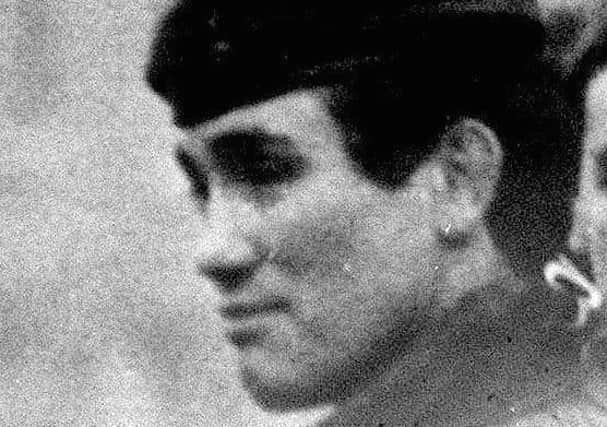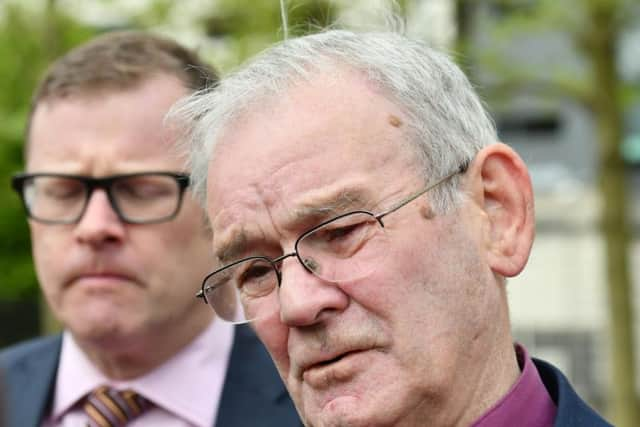'˜Teenager cried for mother before he was shot in face'


The killer stood over Robert Chambers, 18, after he collapsed in a gutter at a Co Armagh roadside from an earlier burst of bullets, and blew his head off, Alan Black said.
A new inquest is being held into the republican killing of 10 Protestant textile workers as they returned from work 40 years ago.
Advertisement
Hide AdAdvertisement
Hide AdMr Black said that Mr Chambers was his apprentice fitter and they had been out all day in the middle of a field fixing a leak.


He had just fallen in love with a girl he called “his Wendy” and his mentor, Mr Black, had agreed to teach him to drive.
Mr Black said: “He gave me a big hug and he danced around the field.”
He added: “My last memory was him lying on the ground a few hours later calling for his mother. He was only wounded at that time.
Advertisement
Hide AdAdvertisement
Hide Ad“I remember the Doc Marten boots, then a gunman came over and shot him in the face. He got his head blown away.


“That’s my last memory of him. Just thinking what that wee lad was thinking, lying in a gutter calling for his mother.”
The textile factory workers were ambushed as they travelled along the Whitecross to Bessbrook road in rural south Armagh on January 5 1976.
It was claimed as a revenge attack for UVF shootings the day before, but the Historical Enquiries Team (HET) said it had been planned much earlier.
Advertisement
Hide AdAdvertisement
Hide AdThe men’s minibus was stopped by a man waving a red light and those on board were asked their religion by a camouflaged gunman with an English accent whom the victims thought was a soldier. The only Catholic was told to run away.
The killers ordered the rest to line up outside the van and then opened fire.
Father-of-three Mr Black was shot 18 times and pretended to be dead.
He gave a statement to the Justice for Innocent Victims of Terrorism group which was read to the coroner.
Advertisement
Hide AdAdvertisement
Hide Ad“I felt the most unbelievable level of pain, as if someone was sticking hot needles into my whole body.
“There was first shooting and then a lull. The only noise to be heard was my colleagues screaming in pain.”
Then the second round of shooting began.
“This time this shooting was targeted and measured, in response to the order to finish them off.
“I watched the gunmen shooting everyone. I was bleeding very badly. I watched them as they shot each one.
Advertisement
Hide AdAdvertisement
Hide Ad“They shot John McConville through the head. I knew my mates were dead because there was no more moaning.
“I felt my body and tried to plug the holes where the blood was coming from.
“There was light rain and I put my head into a small stream of water on the road because my body was so hot.”
The 10 who died were John Bryans, Robert Chambers, Reginald Chapman, Walter Chapman, Robert Freeburn, Joseph Lemmon, John McConville, James McWhirter, Robert Samuel Walker and Kenneth Worton.
Advertisement
Hide AdAdvertisement
Hide AdMr Black has consistently said the gunman who led the attack barked orders in an English accent, leading to speculation that it could have been Captain Robert Nairac - an English army officer who served in south Armagh, was abducted by the IRA and is now one of ‘The Disappeared’.
Neil Rafferty QC, acting for many of the Kingsmills families, explained yesterday that both the 2011 HET report and the testimony of a self-confessed IRA man in 1976/7 both exonerated Nairac by identifying the gunman with the English accent as an IRA man who lived in Dundalk.
The QC cited the HET report where it said: “Within the intelligence records there is reference to Suspect J, a 43 year old man living in Dundalk at the time of the murders. He became of interest to the investigation in 1977, when intelligence named him as one of 11 men involved in the murders. This man who is now dead, is well documented as speaking with an apparent English accent.”
Mr Black said he did raise Nairac with HET investigators, as the name had been so often “bandied about”.
Advertisement
Hide AdAdvertisement
Hide AdThe officers immediately replied to him, he said: “Paddy used to be in the Paras, but he died from cancer”.
However Mr Black repeatedly emphasised that HET seemed to have their statement on the matter “prepared” for him.
He said he did “never got hung up” on rumours about Nairac and that discussion about it never arose from him. He did not speak about the officer out of the respect to him and his family, he added.
Mr Rafferty went on to read from an intelligence report compiled in 1976/7 - shortly after the Kingsmills massacre - based on the testimony of “a self-confessed IRA man”.
Advertisement
Hide AdAdvertisement
Hide AdThe document said it was based on interrogation of “a terrorist” from south Armagh who named 11 fellow IRA men involved in Kingsmills. Although the names were not read out in court the self-confessed IRA man named his colleague who led the Kingsmills attack, adding that he “speaks with a funny accent” and “almost appears to have an English accent”.
Mr Rafferty said that because the suspect with the unusual accent lived in Dundalk, he was never questioned for the massacre, and is now dead.
Mr Black described the gunman with the English accent as being about 5’8” and “squat and very well built”.
The gunman had been “cocky” and “very aggressive” on the night of the shootings, he said, but his face was blackened out and it was not possible to recall what he looked like.
Advertisement
Hide AdAdvertisement
Hide AdThe other survivor of the attack, Richard Hughes, now deceased, never mentioned the lead gunman having an English accent in his statement.
Mr Rafferty asked Coroner Brian Sherrard for guidance on naming dead suspects in court, as the families wished for this to be done. Mr Sherrard said he had an open mind on the question and asked for a written application.
Fiona Doherty QC, acting for Mr Black and the McConville family, also highlighted Mr Black’s “concerns” about “a local man” who had come into his home with HET Chief Dave cox and his officers as part of the investigation into the atrocity.
“At one point when HET visited you in your home, HET were accompanied by a local man,” Ms Doherty said.
Advertisement
Hide AdAdvertisement
Hide AdAt one stage, she added, the Chief Constable had publicly denied that this “local man” had been involved in the Kingsmills massacre.
In response to her questions about the unnamed figure in his home, Mr Black replied: “He did make me very uneasy”.
Ms Doherty emphasised to Mr Black that he should not name the “local man” in open court, which he was careful not to do.
ENDS